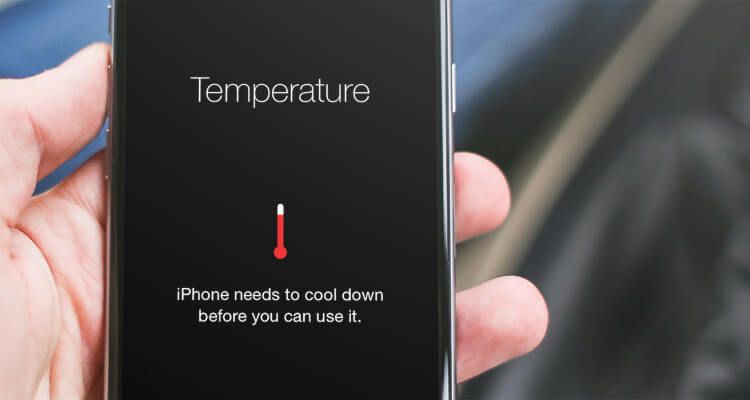

Is your iPhone feeling hot to the touch? Overheating can be a serious issue for smartphones, potentially damaging internal components and affecting performance. Let's explore this topic in more detail with Tiny Fishing below. In this comprehensive guide, we'll delve into the causes of iPhone overheating, discuss preventive measures, and provide step-by-step solutions to help you keep your device cool and functioning optimally.
iPhone overheating is a common problem that can occur for various reasons. Understanding these causes is crucial for preventing and addressing the issue effectively. One of the primary reasons for an iPhone to overheat is intensive usage, particularly when running demanding apps or games for extended periods. The device's processor works harder during these activities, generating more heat than usual.
Another significant factor contributing to overheating is exposure to direct sunlight or high ambient temperatures. iPhones are designed to operate within a specific temperature range, and prolonged exposure to heat can cause the device to struggle with maintaining its optimal temperature. This is especially relevant for users who live in hot climates or frequently use their devices outdoors.
Background processes and apps running continuously can also lead to overheating. When multiple apps are active in the background, they consume system resources and generate heat, even when you're not actively using them. This is particularly true for apps that use location services, perform regular updates, or stream content.
Charging your iPhone, especially while using it simultaneously, can cause the device to heat up. This is because charging generates heat, and when combined with the heat produced from regular usage, it can lead to elevated temperatures. Using non-certified or damaged charging accessories can exacerbate this issue, potentially causing more severe overheating problems.
It's important to note that while occasional warmth is normal, persistent overheating can have serious consequences. Prolonged exposure to high temperatures can damage the battery, reducing its capacity and lifespan. In extreme cases, it can even lead to hardware failures, affecting the overall performance and longevity of your device.
Read more: 10 iPhone Hacks to Save Time Every Day
Prevention is always better than cure, and this holds true for iPhone overheating as well. By adopting some simple habits and making a few adjustments to your usage patterns, you can significantly reduce the risk of your iPhone overheating. Here are some effective preventive measures to keep your device cool:
First and foremost, be mindful of your iPhone's environment. Avoid leaving your device in direct sunlight or in a hot car. If you're in a warm environment, try to keep your iPhone in a cool, shaded place. Using your phone in air-conditioned spaces when possible can also help maintain its temperature.
Managing your apps effectively is another crucial step in preventing overheating. Regularly close apps that you're not actively using, especially those that are resource-intensive. You can do this by double-clicking the home button (or swiping up from the bottom on newer models) and swiping up on the app previews to close them.
Adjusting your iPhone's settings can also make a significant difference. Reduce screen brightness when possible, as a bright screen consumes more power and generates more heat. Similarly, turning off features like Bluetooth, Wi-Fi, and cellular data when not in use can help reduce the workload on your device.
Be cautious about the apps you install and use. Some apps, particularly those that aren't well-optimized or come from unreliable sources, can cause your iPhone to work harder than necessary. Stick to apps from trusted developers and the official App Store to minimize this risk.
When it comes to charging, use only Apple-certified chargers and cables. Avoid using your iPhone while it's charging, especially for tasks that require high processing power. If possible, remove your iPhone case while charging, as some cases can trap heat and interfere with the device's ability to cool itself.
Keeping your iOS updated is also essential. Apple frequently releases updates that include performance improvements and bug fixes, which can help manage your device's temperature more effectively. Enable automatic updates or regularly check for and install the latest iOS version.
Despite taking preventive measures, there may be times when you notice your iPhone getting unusually hot. In such situations, it's crucial to act quickly to prevent potential damage. Here are some immediate actions you can take when your iPhone starts overheating:
The first and most important step is to stop using your iPhone immediately. Close all apps and, if possible, turn off the device completely. This gives your iPhone a chance to cool down without any additional heat generated from usage.
If you're in a warm environment, move to a cooler area. This could mean stepping into an air-conditioned room or finding a shaded spot if you're outdoors. Avoid placing your iPhone in the refrigerator or using any other extreme cooling methods, as rapid temperature changes can cause condensation and potentially damage your device.
Remove any case or cover from your iPhone. While cases are great for protection, they can also trap heat. Taking off the case allows for better heat dissipation, helping your device cool down faster.
If your iPhone is charging when it starts to overheat, unplug it immediately. As mentioned earlier, charging generates additional heat, which can exacerbate the overheating problem. Let your device cool down before plugging it back in.
In case your iPhone displays a temperature warning message, it's crucial to heed this warning. This is a built-in safety feature designed to protect your device from heat damage. The message usually indicates that you should turn off your iPhone until it cools down.
Read more: How to Extend iPhone Battery Life: 15 Proven Tips
If your iPhone continues to overheat frequently despite taking preventive measures and immediate actions, it may indicate a more serious underlying problem. In such cases, consider the following steps:
Perform a thorough software check. Start by updating your iOS to the latest version if you haven't already. Then, check for any apps that might be causing the issue. You can do this by observing which apps are running when your iPhone overheats. Consider uninstalling and reinstalling these apps, or finding alternative apps that serve the same purpose but are less resource-intensive.
Resetting your iPhone to its factory settings can sometimes resolve persistent overheating issues. Before doing this, ensure you back up all your important data. To reset your iPhone, go to Settings > General > Reset > Erase All Content and Settings. After the reset, set up your iPhone as a new device and only install the apps you absolutely need.
If the problem persists even after a factory reset, it might be a hardware issue. In this case, it's best to consult with Apple Support or visit an Apple Store or authorized service provider. They have the tools and expertise to diagnose and fix hardware-related overheating problems.
While addressing immediate overheating issues is important, adopting long-term strategies can help maintain your iPhone's performance and prevent future overheating problems. These strategies not only keep your device cool but also contribute to its overall longevity and efficiency.
Regular maintenance is key to keeping your iPhone running smoothly. This includes periodically checking for and deleting unnecessary files, photos, and apps. The more cluttered your iPhone's storage becomes, the harder it has to work, which can lead to increased heat generation. Use the built-in iPhone storage analyzer (Settings > General > iPhone Storage) to identify and remove large files or apps you no longer need.
Be mindful of your battery health. As batteries age, they become less efficient and may generate more heat. You can check your battery health by going to Settings > Battery > Battery Health. If your battery's maximum capacity is significantly reduced, consider getting it replaced by Apple or an authorized service provider.
Optimize your iPhone's settings for better performance and reduced heat generation. This includes adjusting features like Background App Refresh (Settings > General > Background App Refresh) and Location Services (Settings > Privacy > Location Services). Limiting these features can reduce the workload on your device, thereby reducing heat generation.
Invest in a high-quality, breathable case for your iPhone. While it's important to protect your device from physical damage, some cases can trap heat. Look for cases designed with heat dissipation in mind, often featuring ventilation holes or made from materials that don't insulate heat.
Educate yourself about your iPhone's capabilities and limitations. Understanding what puts stress on your device can help you use it more efficiently. For instance, avoid running multiple demanding apps simultaneously or using your iPhone for extended periods.